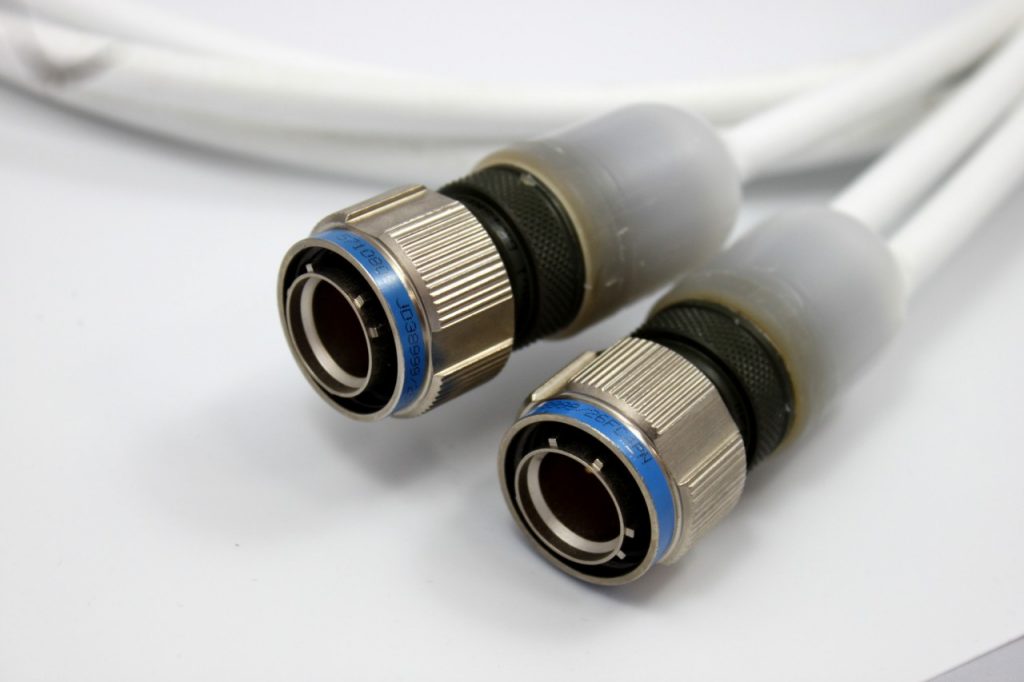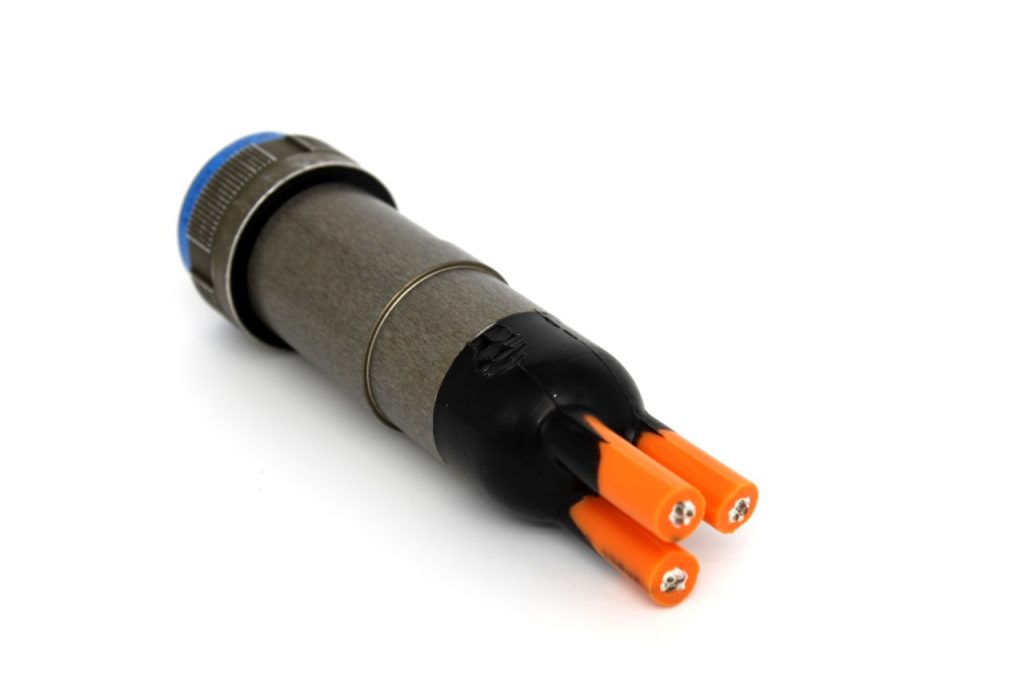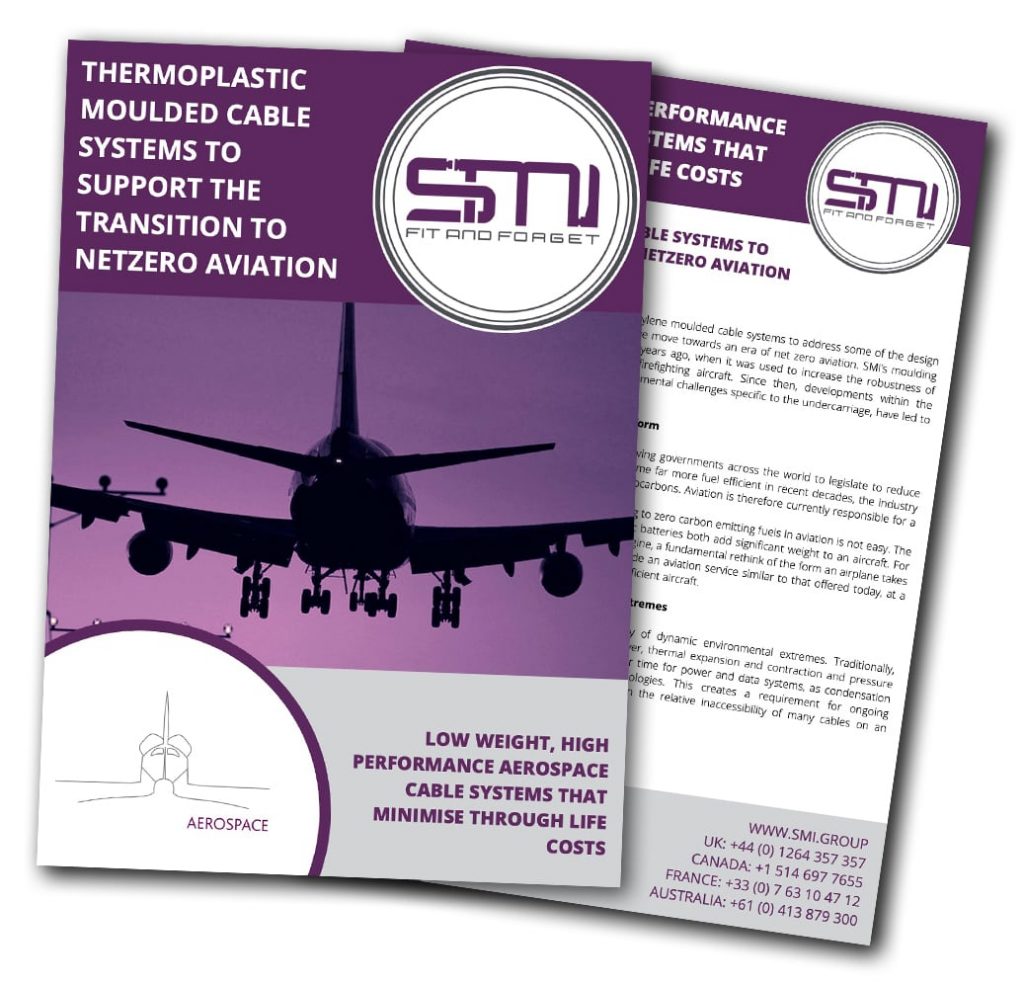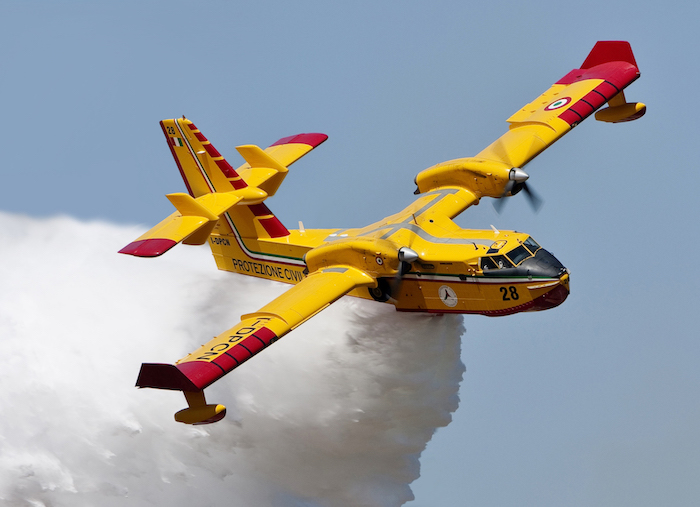Fit and forget aerospace cable systems that minimise through life costs
Thermoplastic polyethylene moulded cable systems address some of the design challenges that aerospace engineers are facing as we move towards an era of net zero aviation. SMI’s moulding technology was first applied in aerospace some 20 years ago, when it was used to increase the robustness of sensors installed on the Bombardier 415 aerial firefighting aircraft. Since then, developments within the electronification of aircraft systems, as well as environmental challenges specific to the undercarriage, have led to further applications of our technology in the Aerospace sector.
Climate change is challenging aerospace to transform
The need to restrict and reverse climate change is driving governments across the world to legislate to reduce carbon emissions. While commercial aircraft have become far more fuel efficient in recent decades, the industry remains dependent on the high calorie content of hydrocarbons. Aviation is therefore currently responsible for a significant proportion of global carbon emissions.
The FlyZero initiative is driving change in UK but switching to zero carbon emitting fuels in aviation is not easy. The two leading proposed alternatives, hydrogen and electric batteries both add significant weight to an aircraft. For perhaps the first time since the introduction of the jet engine, a fundamental rethink of the form an airplane takes is underway. The outcome the industry needs is to provide an aviation service similar to that offered today, at a similar cost, which implies the creation of radically more efficient aircraft.
Flight exposes onboard systems to environmental extremes
Aircraft environments expose cable systems to an array of dynamic environmental extremes. Traditionally, designers have used off-the-shelf cabling products. However, thermal expansion and contraction and pressure cycling during altitude changes can produce problems over time for power and data systems, as condensation pervades connections through traditional sealing technologies. This creates a requirement for ongoing maintenance programmes with regular replacement. Given the relative inaccessibility of many cables on an aircraft, this generates significant through-life costs.
When considering new aircraft designs, reducing overall weight and creating more intelligent optimisation of flight characteristics is required to increase efficiency. Designers will want to remove heavy hydraulic systems in favour of electrical systems. There will also be a proliferation of new electrical systems operating at voltages up to 1kV to provide greater control of the aircraft to gain efficiency. A much larger installed base and performance range of cables, implies even greater costs associated with regular maintenance.
Thermoplastic polyethylene moulded cable systems for aerospace applications
SMI designs and manufactures ‘fit and forget’ cabling solutions that deliver lightweight data, power and control across critical aerospace systems, regardless of operating conditions. Our main manufacturing competency is the use of thermoplastic polyethylene moulding. This technology accommodates thermal expansion, contraction and promises to be the solution to lower partial discharge inception voltages at altitude. Our solutions prevent the ingress of water, dust and aerospace contaminant fluids, including aviation fuels and hydraulic fluids. They also resist mechanical stress, corrosion damage, lightning strike, and biological and chemical contamination.
- Lightweight data, power and control for critical aerospace systems
- Designed and manufactured to perform for the full life of the aircraft
- Accommodates expansion, contraction and partial discharge at altitude
- Prevents all moisture and dust ingress
- Resists mechanical stress, biological and chemical contaminants
- Fit and forget approach significantly reduces through-life costs

Due to these properties, cost and weight saving benefits can be achieved by selecting the most direct cable routing on an airframe – even through fuel tanks, which requires the highest levels of reliability and design assurance. With our ‘fit and forget’ approach to aerospace solutions, complex service and replacement programmes are not required, greatly reducing through-life costs.
Benefits and challenges of polyethylene
SMI makes significant use of polyethylene (PE), a high specification technical plastic, to mould cable harness systems. It is a thermoplastic that has a unique combination of excellent dielectric characteristics particularly at higher voltages, high electrical resistivity, negligible moisture permeation and fluid absorption. It delivers orders of magnitude better insulation resistance than other materials, and this performance does not degrade at higher operating temperatures. Crucially, PE does not absorb fluids or moisture over time as other materials do, which is what makes it the only jacket material that can deliver 30+ years of sealing performance.
However, PE expands and contracts volumetrically by more than 30% when heated to melting point and has a very low thermal conduction coefficient. This makes it notoriously difficult to process, and its low surface energy makes it very difficult to bond to any other materials. Specialist knowledge of the chemistry and compatible processing technology is needed. In general epoxies, polymeric and rubber materials do not bond well, or at all, to PE. Nevertheless, with the right knowledge and processes, exceptional bonding of PE to metals and rigid polymers can be achieved.
SMI’s PE solutions form part of our PlastEthUrm™ range, a dual sealing product so robust that cable mouldings are offered with a standard guarantee of ten years, reflecting the confidence that comes from more than 10,000 installations with zero leaks.
The science of adhesion

For cable harnesses and connectors to provide reliable performance throughout an aircraft’s life, it is crucial that the integrity of their moulded terminations is maintained. This comes down to the science of adhesion, which lies at the intersection of physics, chemistry and mechanics.
In addition to mechanical adhesion, which relies on roughening the adherent surfaces to increase contact area and interlocking, chemical bonding provides a very high strength union, guaranteeing the best long-term resistance to penetration at molecular level.
Chemical bonding occurs when the atoms of adjacent materials containing free electrons and electron holes interact to achieve a lower state of equilibrium, resulting in a chemical bond. By definition, the bond will be stronger than the weaker of the two materials and orders of magnitude greater than any mechanical joint. High pressure and high temperature provided during SMI’s thermoplastic moulding process provides the energy required for this bonding to occur.
During the moulding process, both injected PE granules and the thermoplastic cable jacket are melted. The liquefied plastics flow and mix together so that they cool into a completely homologous material. The cable jacket shape is tailored to incorporate the profile required for the termination without the need for any join or interface. This amalgamation process is absolutely key to long-term sealing, as with no interface present, fluid can never enter a thermoplastic moulding. It also enables complex shapes and geometries to be moulded into harness assemblies.
Tested and approved for aerospace
SMI’s aerospace products are certified and tested to ensure they deliver the long-term performance qualities that we promise our customers.
A test programme based on RTCA DO160 has been completed covering a range of applications of interest to the Aerospace Technology Institute. These have featured fluid compatibility (including Skydrol LD4, Aero HF585B and Aeroshell 33), thermal cycling between +85°C and -55°C, altitude, vibration, operational and crash shock, fungus, salt spray, sand and dust test programmes.
Prior to customer acceptance of products delivered by SMI, hydrostatic pressure testing, including cycling, is carried out. Routine radiographic inspection is also used. Non-destructive X-rays prove the quality of the moulding and establish that bonding across the whole adhered surface has been achieved. This process makes it possible to preclude sources of potential underperformance and guarantees the integrity of mouldings.
Lower total cost of ownership through lighter weight installation options and long-term reliability
It is inevitable that jacketed sealed harnesses will be required in future aerospace systems.
PE mouldings add a small weight penalty in comparison to the current insulated wire electrical harnesses installed in aircraft wings. However, SMI’s moulding technology offers more direct and easier routing of cables, including through fuel tanks, significantly reducing the need for cut outs, doublers and strengthening plates, thus offering significant overall cost and weight savings.
There has been a tendency within aerospace programmes to separate initial capital investment and operational costs into different funding schemes and budgets, disguising the cost of repairing and replacing failing cables and allowing selections to be made based on the initial economy. SMI’s products are built to last the life of the aircraft on which they’re installed. When through life costs of SMI solutions are considered, total cost of ownership is significantly reduced.
With radically different future aircraft and wing designs in development to meet the carbon emissions challenge, consideration should be given to PE moulded cabling as the solution to improved performance, higher voltage, weight saving, greater safety, increased reliability and reduced through-life costs factors that will be required.
About SMI
SMI has a nearly 30-year track record in producing ‘fit and forget’ cable systems for platforms operating in hostile environments. Its products deliver the enhanced performance and dependability required in the aerospace domain while helping to make aircraft lighter and more efficient, as well as reducing their through life costs. SMI sees scope for its products to enable innovative applications across different categories of aircraft, both commercial and military, from large passenger aircraft to smaller airborne platforms. SMI will work with customers from the beginning of the design phase to understand the application and ensure its cable systems deliver the required long-term operational performance.


